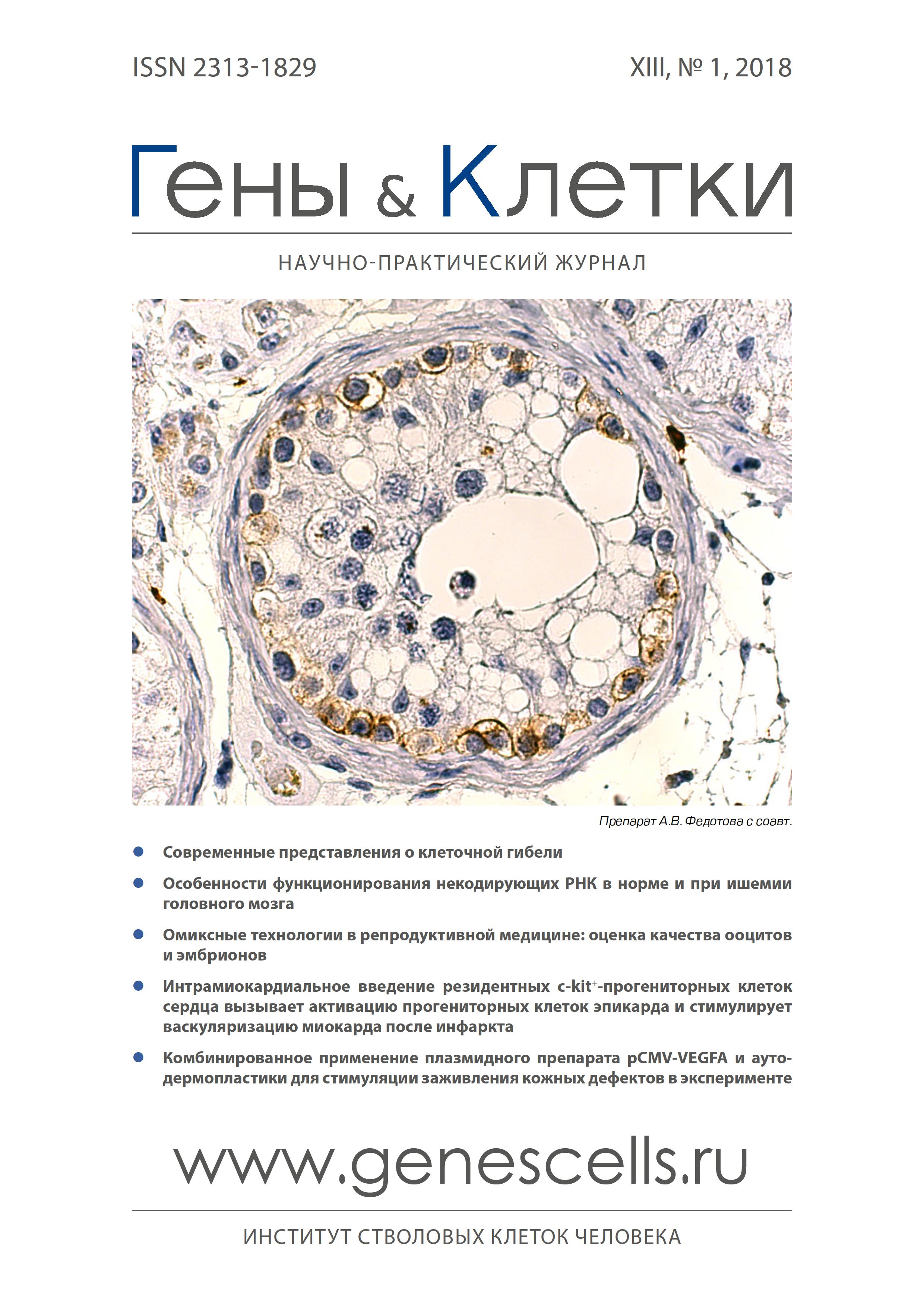Efficacy of combined use of plasmid constructs containing HGF and angiopoietin-1 genes to restore blood flow in ischemic tissues
- Authors: Rubina K.A1, Semina E.V1,2, Diykanov D.T1, Boldyreva M.A2, Makarevich P.I2,3, Parfyonova Y.V1,2, Akopyan Z.A1,3, Tkachuk V.A1,2,3
-
Affiliations:
- M.V. Lomonosov Moscow State University
- Russian Cardiology Research and Production Complex
- Institute of Regenerative Medicine, Medical Research and Education Centre, M.V. Lomonosov Moscow State University
- Issue: Vol 13, No 1 (2018)
- Pages: 56-64
- Section: Articles
- URL: https://genescells.ru/2313-1829/article/view/120721
- DOI: https://doi.org/10.23868/201805006
- ID: 120721
Cite item
Abstract
Full Text
About the authors
KA. A Rubina
M.V. Lomonosov Moscow State University
E. V Semina
M.V. Lomonosov Moscow State University; Russian Cardiology Research and Production Complex
Email: e-semina@yandex.ru
D. T Diykanov
M.V. Lomonosov Moscow State University
M. A Boldyreva
Russian Cardiology Research and Production Complex
P. I Makarevich
Russian Cardiology Research and Production Complex; Institute of Regenerative Medicine, Medical Research and Education Centre, M.V. Lomonosov Moscow State University
Y. V Parfyonova
M.V. Lomonosov Moscow State University; Russian Cardiology Research and Production Complex
Zh. A Akopyan
M.V. Lomonosov Moscow State University; Institute of Regenerative Medicine, Medical Research and Education Centre, M.V. Lomonosov Moscow State University
VA. A Tkachuk
M.V. Lomonosov Moscow State University; Russian Cardiology Research and Production Complex; Institute of Regenerative Medicine, Medical Research and Education Centre, M.V. Lomonosov Moscow State University
References
- Deveza L., Choi J., Yang F. Therapeutic Angiogenesis for Treating Cardiovascular Diseases. Theranostics 2012; 2(8): 801-14.
- Carmeliet P., Jain K. Molecular mechanisms and clinical applications of angiogenesis. Nature 2011; 473(7347): 298-307.
- Xu K., Cleaver O. Tubulogenesis during blood vessel formation. Semin. Cell Dev. Biol. 2011; 22(9): 993-1004.
- Gupta R., Tongers J., Losordo D.W. Human Studies of Angiogenic Gene Therapy. Circ. Res. 2009; 105: 724-36.
- Carmeliet P. VEGF gene therapy: stimulating angiogenesis or angioma-genesis. Nat. Med. 2000; 6: 1102-13.
- Morishita R., Aoki M., Hashiya N. et al. Therapeutic angiogenesis using hepatocyte growth factor (HGF). Curr. Gene Ther. 2004; 4: 199-206.
- Shimamura M., Nakagami H., Taniyama Y. et al. Gene therapy for peripheral arterial disease. Expert Opin. Biol. Ther. 2014; 14(8): 1175-84.
- Ono K., Matsumori A., Shioi T. et al. Enhanced expression of hepa-tocyte growth factor/c-Met by myocardial ischemia and reperfusion in a rat model. Circulation 1997; 95(11): 2552-8.
- Rincon M.Y., Vanden Driessche T. et al. Gene therapy for cardiovascular disease: advances in vector development, targeting, and delivery for clinical translation. Cardiovasc. Res. 2015; 108(1): 4-20.
- Pospelova T.V., Bykova T.V., Zubova S.G. et al. Rapamycin induces pluripotent genes associated with avoidance of replicative senescence. Cell Cycle 2013; 12(24): 3841-51.
- Semina E.V., Rubina K.A., Sysoeva V.Yu. et al. Three-Dimensional Model of Biomatrix as a Method of Studying Blood Vessels and Nerve Growth in Tissue Engineering Structures. Moscow University Chemistry Bulletin 2016; 71(3): 172-7.
- Makarevich P., Tsokolaeva Z., Shevelev A. et al. Combined transfer of human VEGF165 and HGF genes renders potent angiogenic effect in ischemic skeletal muscle. PLoS One 2012; 7(6): e38776.
- Макаревич П.И., Болдырева М.А., Дергилёв К.В. и соавт. Трансплантация клеточных пластов из мезенхимальных стромальных клеток жировой ткани эффективно индуцирует ангиогенез в ишемизированных скелетных мышцах. Г ены и Клетки 2015; 10(3): 68-77.
- Shevchenko E., Makarevich P., Tsokolaeva Z. et al. Transplantation of modified human adipose derived stromal cells expressing VEGF165 results in more efficient angiogenic response in ischemic skeletal muscle. J. Transl. Med. 2013; 11: 138.
- Carmeliet P. VEGF as a key mediator of angiogenesis in cancer. Oncology 2005; 69: 4-10.
- Min J.K., Lee Y.M., Kim J.H. et al. Hepatocyte Growth Factor Suppresses Vascular Endothelial Growth Factor-Induced Expression of Endothelial ICAM-1 and VCAM-1 by Inhibiting the Nuclear Factor-B Pathway. Circ. Res. 2005; 96: 300-7.
- De Haro J., Acin F., Lopez-Quintana A. et al. Meta-analysis of randomized, controlled clinical trials in angiogenesis: gene and cell therapy in peripheral arterial disease. Heart Vessels 2009; 24: 321-8.
- Deev R., Plaksa I., Bozo I. et al. Results of an International Postmarketing Surveillance Study of pl-VEGF165 Safety and Efficacy in 210 Patients with Peripheral Arterial Disease. Am. J. Cardiovasc. Drugs 2017; 17(3): 235-42.
- Kim J., Mirando A.C., Popel A.S. et al. Gene delivery nanoparticles to modulate angiogenesis. Adv. Drug Deliv. Rev. In press 2016.
- Banfi G., von Degenfeld R., Gianni-Barrera S. et al. Therapeutic angiogenesis due to balanced single-vector delivery of VEGF and PDGF-BB. FASEB J. 2012; 26: 2486-97.
- Makarevich P., Tsokolaeva Z., Shevelev A. et al. Combined transfer of human VEGF165 and HGF genes renders potent angiogenic effect in ischemic skeletal muscle. PLoS One 2012; 7(6): e38776.
- Spanholtz T.A., Theodorou P., Holzbach T. et al. Vascular endothelial growth factor (VEGF165) plus basic fibroblast growth factor (bFGF) producing cells induce a mature and stable vascular network - a future therapy for ischemically challenged tissue. J. Surg. Res. 2011; 171: 329-38.
- Kupatt C., Hinkel R., Pfosser A. et al. Cotransfection of vascular endothelial growth factor - A and platelet-derived growth factor-B via recombinant adeno-associated virus resolves chronic ischemic malperfusion role of vessel maturation. J. Am. Coll. Cardiol. 2010; 56: 414-22.
- Su H., Takagawa J., Huang Y. et al. Additive effect of AAV-mediated angiopoietin-1 and VEGF expression on the therapy of infarcted heart. Int. J. Cardiol. 2009; 133: 191-7.
- Yu J.X., Huang X.F., Lv W.M. et al. Combination of stromal-derived factor-1alpha and vascular endothelial growth factor genemodified endothelial progenitor cells is more effective for ischemic neovascularization. J. Vasc. Surg. 2009; 50: 608-16.
- Макаревич П.И., Рубина К.А., Дыйканов Д.Т. и соавт. Терапевтический ангиогенез с применением факторов роста: современное состояние и перспективы развития. Кардиология 2015; 9: 59-71.
Supplementary files










